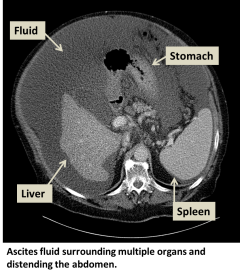Ascites
Find your care
Our board-certified physicians diagnose and treat many vascular conditions. Call 310-481-7545 to learn more about interventional radiology services.
What is ascites?
Ascites is the accumulation of fluid in the peritoneal cavity, the potential space around the organs within the abdomen. Ascites is caused by fluid leaking out from blood vessels as a result of various disease processes.

Risk Factors
Ascites most frequently results from liver damage. As the liver gets injured from toxins or infection, the substance of the liver scars and becomes stiffer, resulting in high pressure in the blood vessels within the liver, called portal hypertension. The increased pressure causes fluid to leak out of the blood vessels and build up in the peritoneal cavity.
Conditions and risk factors for ascites include:
- Cirrhosis (liver scarring), which can be caused by:
- History of alcohol use
- Hepatitis B or C infection
- Long term inflammation of the liver
- Hemochromatosis, or iron overload
- Cancer of abdominal organs, such as liver, pancreatic, ovarian, uterine, and colon cancer
- Budd-Chiari syndrome
- Congestive heart failure
- Peritonitis, an infection in the abdominal cavity
- Pancreatitis
- Tuberculosis
Symptoms
Symptoms can develop gradually or suddenly, and mild ascites may initially seem just like weight gain, depending on the amount of abdominal distension.
- Abdominal distension
- Bloating
- Weight gain or weight loss with increased abdominal distension
- Abdominal pain
- Shortness of breath
- Edema (swelling) in legs
- Bruising
- Encephalopathy
Diagnosis
Ascites can be detected with a physical exam or ultrasound. Your physician may look for "shifting dullness" to check if abdominal sounds change as the abdominal fluid moves.
Other tests to look for causes of ascites and check organ functions include:
- Paracentesis, a procedure to withdraw abdominal fluid
- Liver function tests
- Kidney function tests
- Blood tests for protein and electrolyte levels
Treatments
- Paracentesis (removal of abdominal fluid)
- Pleurex (indwelling catheter to allow at-home drainage of abdominal fluid)
- TIPS
For More Information:
For more information or to schedule an appointment with one of our IR physicians, please call 310-481-7545.